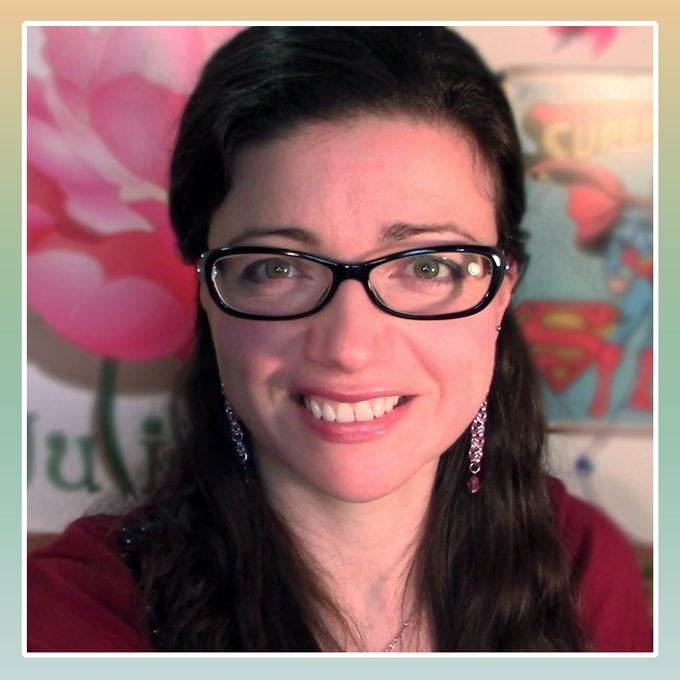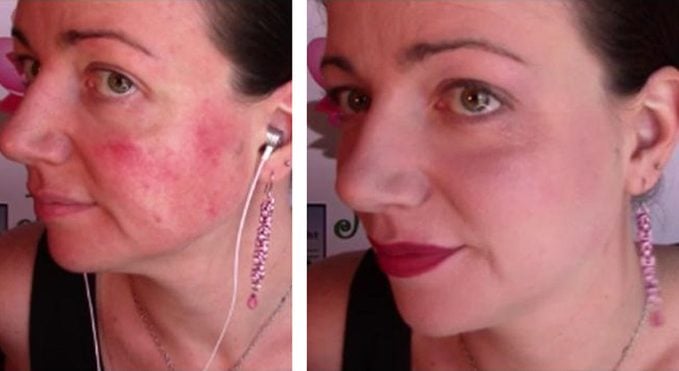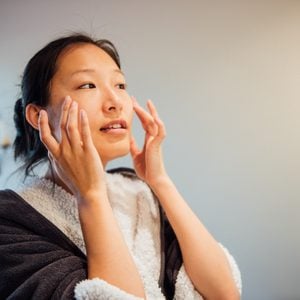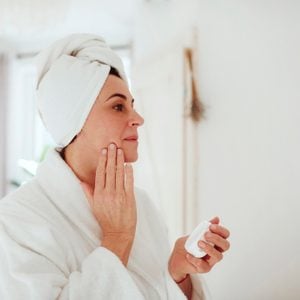I’ve Had Rosacea for 15 Years and These Are the Treatments that Worked
Updated: Feb. 03, 2021
A woman shares her years-long journey with rosacea, from misdiagnosis and failed treatments to uncovering the strategies, lifestyle tweaks, and skin care routine that help her keep this skin condition under control.
Our editors and experts handpick every product we feature. We may earn a commission from your purchases.

Sharing a rosacea journey
Even though millions of people live with rosacea, many struggle with how to handle the skin condition that causes redness and visible blood vessels on your face. For years, Julie Campbell was one of those people. After trying multiple medications that didn’t work consistently, she thought the constant redness and bumps on her cheeks would become a regular part of her life. Here, she shares her journey with rosacea—from embarrassment and frustration to healing.
The first rosacea symptoms
I was around 20 years old when I first started experiencing redness in my cheeks, sometimes accompanied by pimple-like bumps. Given my age, my doctor diagnosed me with acne and prescribed some antibiotics and topical medications. At the time, I had no reason to suspect it was anything but acne. Even when the meds made the redness worse and caused burning, stinging, and peeling, I simply assumed I’d been given the wrong medication. It never crossed my mind that I had been misdiagnosed.
The first time I heard the term rosacea was, surprisingly, from my dentist. During a standard head and neck check as part of a routine cleaning, he commented that my redness was “possibly something like rosacea.”
This was the first time I considered that I might have something besides acne, so I went home and started searching my symptoms online. Rosacea came up a few times, but this was over 15 years ago and there wasn’t much information beyond the most basic definition.
So I ignored it for a while. I thought it was just a bit of redness and that it was only temporary. I did have the occasional flare-up, which ranged from a half hour of redness, burning, or itching to days of swollen, almost purple cheeks with whitehead-like pimples and dry, red eyes that felt like they were full of sand. I did my best to cover it up with makeup and figured I would mention it to my doctor at my next appointment.
But by the time that appointment rolled around a few months later, I had some permanent redness in my face—not much; I just looked rosy-cheeked all the time.
My doctor examined my skin, pressing on my cheeks to see if the redness would fade with pressure (like it would with a sunburn), but it didn’t. From there, he confirmed my suspicions: I didn’t have adult acne. I had rosacea.

Starting treatment
My first treatment was a choice between Metrocreme and Metrogel, two topical versions of metronizadole. I picked a cream and assumed that if I applied it as directed the rosacea would go away and that would be that.
After about six weeks, that’s exactly what happened: The redness started fading and the occasional flare-ups became even less frequent.
But just a few months after that, the progress stopped. It was as if the medication just gave up. My doctor switched me to the gel, which I stopped using before the tube was even empty.
Taking a step back
Instead of pursuing another treatment or analyzing my lifestyle for the reasons behind my rosacea flare-ups (it wasn’t until much later that I started making connections between my worsening rosacea and certain foods, emotions, and habits), I gave up on finding a treatment.
I chose to live with whatever form the rosacea decided to take. And the burning, stinging, and redness became regular parts of my day. I covered up with makeup when possible and just tried to live my life.
Finding the right treatment
A few years into what I thought was my new normal I moved to a new city. Since that also meant finding a new doctor, I decided to try again. My new doctor prescribed a different form of the same medication I’d taken years earlier.
Just like before, it worked for a few months and then stopped. Still, I was planning to request a dermatologist referral when I stumbled across information on LED light therapy for rosacea. I didn’t know it at the time, but it was my first breakthrough.
I started researching red light therapy for rosacea and the information I found seemed promising, so I ordered a kit. All I had to do was shine the light six to 12 inches away from my face for 90 seconds per area, once a day.
The light was supposed to penetrate the skin, reducing inflammation, and healing the damage. And it worked! The redness, swelling, and bumps all began to disappear.
Identifying rosacea triggers
That was five years ago. Since then, I’ve been experimenting with natural ways to treat my rosacea. I found a lot of excellent information at the National Rosacea Society, which is where I learned about common rosacea triggers. They have a diary that can be used to track flare-ups and pinpoint triggers, which I downloaded immediately.
Using it, I was able to pinpoint all the triggers that cause my rosacea to flare: stress, anxiety, and sunlight are my top three by far. Other triggers include heat (hot weather or hot foods), extreme cold, seasonal allergies, and spicy foods, as well as certain herbs and spices, alcohol (especially red wine), certain cosmetics, lack of sleep, many household cleaning products, and artificial fragrances.
If I feel a flare-up coming on, my main strategy is to keep cool and stay calm because getting stressed makes it worse. Cooling my body, particularly around my neck, often helps.
I try not to touch my face or use water or ice to cool it directly since that only makes things worse. Mostly I try to keep cool, physically and emotionally, and wait for it to pass.
Finding a daily rosacea skin care routine
These days, I have a careful rosacea skin care routine that I follow consistently. I use the Chamomile Floral Water, Chamomile Cleansing Cream, Isla Oil, and Cosmic Cream from Noble Naturals. I also use Bedrock Balm from Bedrock Skin. I find that this combination helps keep my dry and reactive skin calm and moisturized in all seasons.
I used to use light therapy daily, but these days I use it on a weekly basis. Red and amber wavelengths work best for me, but I’ve had some luck with green light therapy, as well.
I use a gentle zinc oxide-based sunscreen whenever I go outside and stay in the shade as much as possible. I don’t drink alcohol and I avoid spicy food and other foods that I know are triggers.
I try to fill my plate with nutritious, quality ingredients, most of which I get from my local farmers markets. I’m prone to insomnia, which I know can lead to flare-ups, so I keep a regular bedtime and a set bedtime routine which includes sleep meditations. (Here are home remedies for rosacea that doctors recommend.)
Thriving with rosacea
Rosacea has played a surprisingly large role in my life and one that has evolved quite a bit over the years. It started off as a source of embarrassment that I felt had to be covered up.
But when I started my blog Rosy JulieBC and began sharing my Rosy Lifestyle with others, it provided me with a positive and inspiring mission.
More recently, rosacea has become something I’ve accepted, something that encourages me to live a healthier lifestyle and treat myself with more respect.
Rosacea is no longer the enemy. Sure, it’s a discomfort and a nuisance at times. But it’s something I’ve learned to live with. I would never call it a friend but it has taught me to be a friend to myself.



